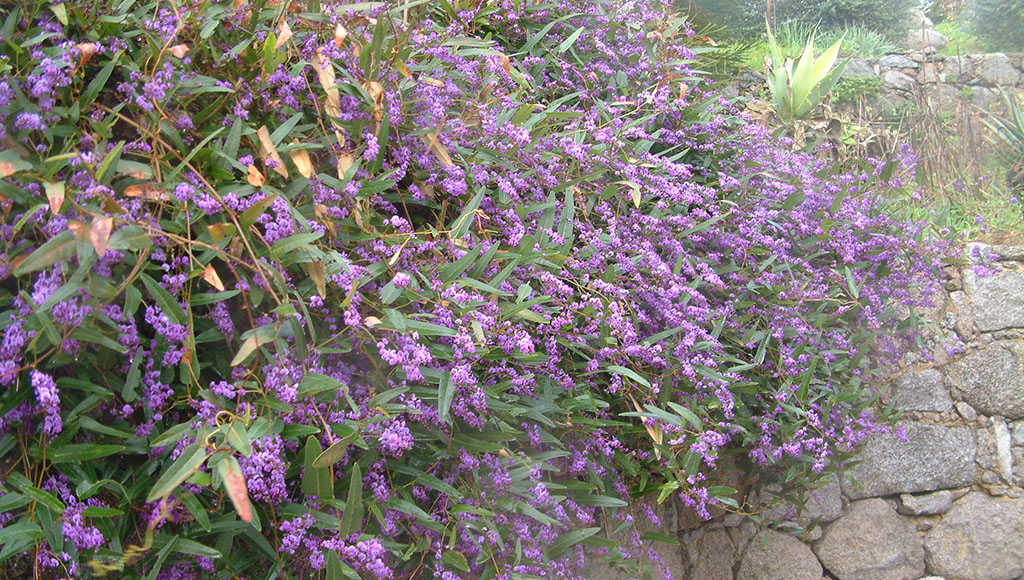The Algarve is classified as zone 9/10 in the USDA hardiness designation. This classification is in common with the two mediterranean zones in Australia. Both the south-western (centred on Perth) and southernmost parts of the continent (around Adelaide) are mediterranean.
Maybe you are already selecting a lot of Australasian plants for your Algarve garden without being aware of the fact. Generally speaking, many Australian plants prefer a neutral to acid soil with good drainage. They are good for sandy littoral and schisty soils of the serra but can struggle on the chalky clays of the Barrocal zone.
The native flora of Australia has almost no native succulents, unlike the rich diversity available from Africa. However, the choice of woody plants from Australia is well worth investigating.
A popular choice is Grevillea robusta (Silky Oak). Five years after planting, they can reach five metres or more. Young trees can be upright and symmetrical. Their (evergreen) divided leaf colour and shape is different from other trees but the underside of the leaf matches almost perfectly the silvery grey of the adjacent olives. The real show starts with yellow/orange flower clusters upright on the branches from spring through to early summer.
Also common is Melia azedarach. They are not only Australian but also found in SW Asia, China and Japan. Growth can be impressive, 4.5m in five years. The purple blossom is scented and colourful; the orange berries that overwinter make a superb contrast with our deep blue skies. The tree is deciduous but contributes well as a summer shade giver. They are widely used as street trees which is a good recommendation.
It is a sad fact that the landscapes of central Portugal are dominated by Eucalyptus globulus. The attraction of rapid growth, with multi-stemmed regrowth, has made them popular as a cash crop. They compete with native flora and fauna to the detriment of the latter; they also burn vigorously and will explode, spreading fire even further.
You may not be aware that Portugal is the leading producer of toilet paper in Europe, thanks to E. globulus. The paradox of this tree is that, although widely planted in commercial industrial-type monocultures, it is classed as highly invasive, and some local councils have banned it.
Acacias grow here freely, are very widespread and can look as if they belong. There are 11 species mentioned in the invasive plant list and they seed copiously. Avoid them at all costs! The invasive plant database for Portugal has advice on an efficient way of killing them – do not cut down, simply strip off the lower metre of bark and you will have a good source of firewood for the following year.
Other popular, but non-invasive, street trees are Brachychiton acerifolius and B. populneus. Brachychiton is a genus of 31 species of trees and large shrubs, native to Australia and New Guinea. Fossils from New South Wales and New Zealand are estimated to be 50 million years old. They grow to 4-30m tall, and some are dry-season deciduous. Some have spectacular flame-coloured flowers, but hairs inside the seed pods are very irritant and can be dangerous. Many of them are pachycauls (trees with large or swollen trunks) with the most noticeable being the iconic Queensland Bottle Tree (Brachychiton rupestris).
There are excellent examples in Algarve gardens of Hymenosporum flavum (Australian frangipani). With some limited summer watering, it will grow away well and is suitable for smaller gardens. This is a tree with generous amounts of cream-to-yellow-scented flowers produced in early summer.
Also seen in Algarve gardens is the New Zealand Christmas Tree – Metrosideros excelsa, which can grow into a large shrub or tree. It is slow-growing but drought-tolerant and, when it does flower, the plant is covered in bright red, showy, bottle brush-type flower clusters.
Other Australian plants which are available here:
Banksia: as vigorous and showy as the better-known South African proteas, good for schisty soils
Callistemon (Bottle Brush) shrubs: commonly available is red flowering C. citrinus
Eremophila: desert shrubs in a range of sizes and flower colour, all tough and drought-tolerant.
Grevillea rosmarinifolia: spectacular orange/red flower colour and graceful form.
Hardenbergia violacea: vigorous climber, easy to start from cuttings, and a lovely sight in full flower.
Leptospermum scoparium: (Manuka) native to New Zealand and eastern Australia. Easily pruned to produce a tidy mass of long-lasting flower colour throughout the winter.
Pandorea pandorana: a very vigorous climber with beautiful pink flowers in the early winter.
It is worth checking on the ‘Invasive Plant’ database for Portugal before planning your Australian garden. Do not “plant in haste only to repent at leisure”. There are many plants from Australia which are not invasive, but which will thrive in our Algarve gardens with little or no irrigation.
Australian Native Plant Society
Australian Plant Society has a seed list for members
By Rosie Peddle
|| features@algarveresident.com
289 791 869 | mgapsec@gmail.com
facebook.com/MedGardenersPortugal
www.mgaportugal.org




















